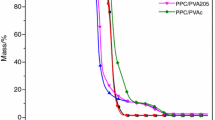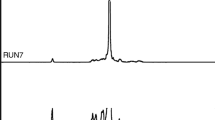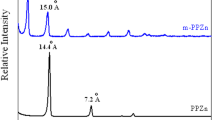Abstract
Poly(cyclohexene carbonate) (PCHC) is an alternative copolymer of carbon dioxide and cyclohexene oxide. Severe thermal decomposition occurs during melt processing of PCHC, thus, it is important to find the reason for thermal decomposition and raise its thermal stability. In this report, as-polymerized PCHC was obtained under Y(CCl3COO)3-ZnEt2-glycerin rare earth coordination ternary catalyst. The pyrolysis gas chromatography with mass spectrometry analysis disclosed that chain unzipping depolymerization dominated the thermal decomposition process. The residue metal (mainly ZnO in this catalyst system) was important in PCHC degradation, and the onset decomposition temperature of PCHC containing 5 ppm zinc was 56 °C higher than that of PCHC containing 4,400 ppm Zn, corresponding to apparent activation energy change from 190 KJ/mol to 146 KJ/mol. When PCHC was subjected to melt processing, its average molecular weight decreased more rapidly, as it contained more catalyst residue, indicating metal residue in PCHC could accelerate the decomposition process, and removing the metal residue should be effective in raising its thermal stability.
Similar content being viewed by others
Explore related subjects
Discover the latest articles, news and stories from top researchers in related subjects.Avoid common mistakes on your manuscript.
Introduction
Since the pioneering work of Inoue in 1969 [1, 2], aliphatic polycarbonate from alternating copolymerization of carbon dioxide and epoxides has become promising biodegradable plastics, not only for its fixation of CO2, but also for its potential application as a biodegradable material. Till now much progress has been achieved, especially in highly active and selective catalyst systems [1, 3–12]. One of the progresses is the commercialization of high molecular weight poly(propylene carbonate) (PPC) from CO2 and propylene oxide by rare earth coordination ternary catalyst [6, 13, 14]. Although PPC has shown important applications in biodegradable food and medical packaging, the dimension stability of PPC at temperatures above 40 °C is still not satisfactory, since it is an amorphous polymer with low glass transition temperature (Tg of Ca. 35 °C). As shown in Scheme 1, poly(cyclohexene carbonate) (PCHC) is an alternative copolymer from cyclohexene oxide and CO2, it has Tg of over 115 °C approaching that of bisphenol-A polycarbonate (150 °C), which has good dimension stability at temperatures above 100 °C. As a new biodegradable polymer suitable for high-temperature application and as a promising alternative to engineering resins, PCHC may provide a solution to the poor dimension stability of PPC. This may help PCHC become the most important CO2 copolymer next to PPC. However, PCHC degrades severely during melt processing, leading to great deterioration in mechanical performance. To improve the thermal stability of PCHC, factors influencing the thermal degradation of PCHC must be understood and an effective way to improve its thermal stability must be determined.
Two thermal degradation mechanisms have been proposed for PPC, namely, chain unzipping degradation and chain random scission [15, 16]. The chain-unzipping degradation due to the backbiting of terminal hydroxyl group on carbonate carbon produces cyclic carbonate, which can be significantly depressed by end-capping [17–19]. However, since the chain random scission occurs through decarboxylation, a new hydroxyl end group can be produced, accompanied by a chain unzipping degradation. Therefore, for end-capped PPC, although the first degradation is restricted to chain random scission, the chain-unzipping reaction exists after chain scission.
Traces of transition metal ions often behave as degradation catalysts in polymeric materials with or without oxygen. Despite investigations on the thermal properties of PCHC [20, 21], few results are available on the influence of the metal residue on the thermal stability of PCHC [22]. Our results indicate that metal residue on a 15,000 ppm scale exists in the as-polymerized PCHC due to catalyst transformation during post-polymerization treatment, which may influence thermal behavior. Furthermore, this paper will investigate the thermal degradation behavior of PCHC using pyrolysis gas chromatography with mass spectrometry (Py-GC/MS), focusing on the effects of metal residue amount on its decomposition kinetics parameters based on thermogravimetric analysis (TGA) data. This paper also attempts to provide a method to improve the thermal stability of PCHC.
Experiment
Materials
Cyclohexene oxide (CHO) and 1,3-dioxane were refluxed over calcium hydride for 20 h and distilled prior to use. Glycerol was distilled under reduced pressure prior to use. Yttrium trichloroacetate, (Y(CCl3COO)3), was synthesized according to literature [23] and heated in vacuum at 80 °C for 48 h before use. Diethyl zinc (ZnEt2) synthesized according to literature [24] was in purity of 97% and used directly. The rare earth metal coordination ternary catalyst was prepared according to literature [25]. Commercial CO2 (99.99% purity) was used without further purification.
Preparation of PCHC with different zinc (Zn) contents
Copolymerization reaction was performed in a stainless autoclave equipped with a mechanical stirrer. After the autoclave was dried in vacuum at 85 °C for 10 h, the rare earth coordination ternary catalyst was brought into the reactor followed by the introduction of CHO in 1,3-dioxane solution. The autoclave was then pressurized with CO2 to 4.0 MPa, and heated to a reaction temperature of 80 °C. The copolymerization reaction last for 8 h, and the reactor was vented after cooling. The as-polymerized PCHC was precipitated from the solution by water. To prepare PCHC with different Zn content, the as-polymerized PCHC was dissolved in CH2Cl2, and precipitated by a 5% HCl aqueous solution. It was then washed with distilled water/ethanol solution until the filtrate became neutral. The dissolution/precipitation process was repeated several times to obtain PCHC with different Zn content.
To prepare the PCHC film, the chloroform solution of PCHC was cast on the surface of a glass Petri dish. After it was placed at room temperature for 2 days and most of the solvent evaporated, the film was washed with methanol and vacuum dried.
Monitoring the degradation of PCHC under melt process
Melt degradation were carried out in a Haake batch intensive mixer (Haake Rheomix 600, Germany) with a batch volume of 50 mL. Polymers were melted at 180 °C at 50 r/min screw speed for 5 min. The torque was continuously monitored during the entire mixing process.
Characterization
The molecular weight of PCHC was measured at 30 °C on a Waters 2414 gel permeation chromatograph (GPC) system with a refractive index (RI) detector in polystyrene standard using CH2Cl2 as eluent at a flow rate of 1.0 mL min−1.
To measure the Zn content in PCHC, PCHC was degraded by a 25% ammonia solution, dissolved in 1 mol/L hydrochloric acid, and then the Zn content was measured with a PE-Analyst 800 atomic absorption flame emission spectrophotometer (AA).
TG (TG/DTA) of PCHC film was conducted on Perkin-Elmer TGA 7 under a constant nitrogen flow (100 ml min−1), at a heating rate of 5, 10, 15, and 20 °C/min from room temperature to 450 °C.
Pyrolysis-gas chromatograph/mass spectra (Py-GC/MS) of PCHC samples were conducted from 40 °C to 400 °C at a heating rate of 10 °C min−1 on a Frontier Lab double-shot pyrolyzer PY-2020D with a Frontier Lab SS-1010E selective sampler and a Shimadzu GC/MS-QP5050 chromatograph/mass spectrometer. High-purity helium was used as carrier gas at 50 ml min−1.
Results and discussion
Preparation of PCHC samples with different Zn contents
The number average molecular weight (Mn) and weight average molecular weight (Mw) of PCHC with various Zn (PCHC-n) are listed in Table 1. The Mn, Mw, and Zn content of the as-polymerized PCHC (PCHC-0) were 48.9 kg/mol, 639.7 kg/mol, and 15,000 ppm, respectively. After repeating the dissolution/precipitation procedure thrice, the Zn content in PCHC was reduced to Ca. 5 ppm. Mn increased from 48.9 to 69.6 kg/mol, mainly due to the removal of oligomer during the dissolution/precipitation process. The change in Mw was complicated, but a decreasing tendency was observed, and the polydispersity decreased from 13.1 to 5.0.
Thermal pyrolysis behavior of PCHC
PCHC-1 and PCHC-3 were selected to investigate the thermal decomposition behavior using Py-GC/MS, since the Zn content of PCHC-0 was too high. Figure 1 shows the Py-GC/MS total ion current spectra of PCHC-1 (a, b, c) and PCHC-3 (e, d, f) at different pyrolysis temperature.
The characteristic peaks in the Py-GC/MS (TIC) spectra were assigned as follows. The retention time of Ca. 2.5–3.1 min corresponded to CO2, and that of Ca. 6.9–7.8 min was from CHO, that of Ca. 10–11 min was from 1,2-cyclohexanediol, while those from 14 to 15.5 min for PCHC-3 and 14–18 min for PCHC-1 due to the chain-unzipping product of CHC. At a lower pyrolysis temperature of 300 °C, as shown in Fig. 1a and d, the pyrolysis spectrum of PCHC-3 had only two sharp peak characteristics of CO2 and CHC. The pyrolysis spectrum of PCHC-1 was more complicated at around 12–18 min. The intensity of the CHC peak in the Py-GC spectra of PCHC-1 was much stronger than that in PCHC-3, indicating that the latter was more stable than the former, which confirmed that residue Zn enhanced the unzipping reaction. The possible unzipping reaction mechanism due to the Zn catalysis was shown in Scheme 2.
When the pyrolysis temperature increased to 400 °C, in addition to the increase of peak intensity corresponding to the unzipping product of CHC, the spectrum became complicated. The peaks characteristic of CHO and 1,2-cyclohexanediol appeared, indicating that random chain scission existed. Correspondingly, the pyrolysis curve at 500 °C was more complicated, and many unexpected products appeared, indicating that the pyrolysis reaction became uncontrollable at this temperature.
Kinetics analysis of PCHC degradation
To understand the thermal degradation behavior of PCHC with various Zn content, weight loss of PCHC at increasing temperature under N2 atmosphere was measured. As shown in the TG curves in Fig. 2, all curves showed nearly complete degradation, and the onset decomposition temperature (Td) decreased with increasing Zn content. The Td of PCHC-3 with Zn content of 5 ppm was 282 °C, while that of PCHC-1 was 226 °C. A 56 °C increase was observed when the Zn content decreased from 4,400 ppm to 5 ppm, indicating that residue Zn (existing as ZnO) accelerated the thermal degradation of PCHC, which was consistent with previous work [16].
Generally, the kinetic parameters for polymer degradation could be evaluated by TGA [26–34]. For example, the apparent activation energy (E a ) can be estimated by the Kissinger method [26], calculating from the slope of a plot of \( \ln \left( {\frac{\beta }{{{T_m}^2}}} \right) \)vs. (1/Tm) based on Eq. 1:
where β was the heating rate, T m was temperature corresponding to the inflection point of the thermal oxidative degradation curves as the maximum reaction rate, A was the pre-exponential factor, α m was the maximum conversion, and n was the reaction order.
Figure 3 showed the Kissinger plot of ln(β/T m 2) vs. 1/T m for PCHC with various Zn content. The activation energy for the decomposition of the PCHC was estimated according to Equation (1). It was 199.9 KJ/mol and 143.9 KJ/mol for PCHC-3 (Zn content of 5 ppm) and PCHC-1 (Zn content of 4,400 ppm), respectively.
The apparent activation energy could also be calculated by the Flynn-Wall-Ozawa (FWO) method, where it can be directly obtained from weight loss versus temperature curves at different heating rates, according to Eq. 2:
where β, A, R, and E a were the same as those in Eq. 1, T was the absolute temperature, and g(α) was the integral function of conversion.
The activation energy at different conversion can be calculated from the plot of lnβ against 1,000/T as shown in Fig. 4. The nearly parallel fitted straight lines indicated the suitability of this method to the entire degradation process. From the slopes of the set of fitted straight lines, the apparent activation energies for PCHC-3 at different conversion were shown in Table 2, and a mean value of 185.9 KJ/mol was obtained. The same method was used to acquire the apparent activation energy of PCHC-1. The mean value was 146.6 KJ/mol, which was comparable with those obtained using the Kissinger method. The existence of the Zn compound reduced the apparent activation energy of PCHC thermal degradation, an increase of Ca. 45 KJ/mol was observed between PCHC-1 (Zn content of 4,400 ppm) and PCHC-3 (5 ppm). This was consistent with early reports on the effects of metal compounds on the degradation behavior of biodegradable polymers like poly(lactic acid), poly(hydroxyl butyrate), and poly(ε-caprolactone) [35, 36]. Therefore, removing the residue Zn was effective in improving the thermal stability of PCHC.
To understand the effect of Zn content on the degradation of PCHC under melt processing conditions, the changes in molecular weight and polydispersity were measured after melt processing. Figure 5 showed that the Mw of PCHC generally decreased, and became more severe with increasing Zn content in PCHC. For example, after melt processing, the Mw and polydispersity of PCHC-0 (Zn content of 15,000 ppm) decreased from 639.7 kg/mol and 13.1 to 314.1 kg/mol and 6.0, respectively, a Ca. 50% decrease was observed. The Mw and polydispersity of PCHC-1 with Zn content of 4,400 ppm decreased from 274.5 kg/mol and 5.9 to 87.1 kg/mol and 2.6 before and after melt processing, respectively, also Ca. 50% decrease existed. For PCHC-3 with Zn content of Ca. 5 ppm, the Mw and polydispersity decreased from 347.8 kg/mol and 5.0 to 269.6 kg/mol, 3.6 before and after melt processing, respectively. Only a 22% decrease was observed, again indicating that the Zn compound accelerated the decomposition process. Furthermore, the samples were analyzed by 1H-NMR technique. As shown in Fig. 6, the signal at δ = 3.78 ppm was assigned to -CH of cyclohexene carbonate, which produced from the unzipping depolymerization of PCHC. In addition to the new peak characteristics of cyclohexene carbonate, other peaks in the 1H-NMR spectra were similar to each other before and after melt processing, indicating that the backbone structure of PCHC did not change even though the molecular weight decrease phenomenon was observed.
Conclusions
The influence of Zn content due to catalyst transformation on the thermal degradation of PCHC was studied, the residue Zn compound accelerated thermal degradation of PCHC. The apparent activation energy for PCHC thermal degradation obtained from the Kissinger or FWO method was in good agreement with each other. The apparent activation energy of PCHC with 4,400 ppm Zn was about 45 KJ/mol lower than that of PCHC with less than 5 ppm Zn. Removing the Zn compound residue was effective in improving the thermal stability of PCHC.
References
Inoue S, Koinuma H, Tsuruta T (1969) Makromol Chem 130:210
Inoue S, Koinuma H, Tsuruta T (1969) J Polym Sci Part B: Polym Lett 7:287
Kuran W, Pasynkiewicz S, Skupinska J, Rokicki A (1976) Makromol Chem 177:11
Soga K, Uenishi K, Hosoda S, Ikeda S (1977) Makromol Chem 178:893
Aida T, Ishikawa M, Inoue S (1986) Macromolecules 19:8
Chen XH, Shen ZQ, Zhang YF (1991) Macromolecules 24:5305
Darensbourg DJ, Holtcamp MW (1995) Macromolecules 28:7577
Cheng M, Darling NA, Lobkovsky EB, Coates GW (2000) Chem Commun 2007
Darensbourg DJ, Rainey P, Yarbrough J (2001) Inorg Chem 40:986
Lu XB, Wang Y (2004) Angew Chem Int Edit 43:3574
Ren WM, Zhang X, Liu Y, Li JF, Wang H, Lu XB (2010) Macromolecules 43:1396
Yoo J, Na SJ, Park HC, Cyriac A, Lee BY (2010) Dalton Trans 39:2622
Tan CS, Hsu TJ (1997) Macromolecules 30:3147
Liu BY, Zhao XJ, Wang XH, Wang FS (2001) J Polym Sci Part A: Polym Chem 39:2751
Inoue S, Tsuruta T (1975) Applied Polymer Symposia 26:257
Liu BH, Chen LB, Zhang M, Yu AF (2002) Macromol Rapid Commun 23:881
Dixon DD, Ford ME, Mantell GJ (1980) J Polym Sci Part B: Polym Lett 18:131
Lai MF, Li J, Liu JJ (2005) J Therm Anal Calorim 82:293
Peng S, An Y, Chen C, Fei B, Zhuang Y, Dong L (2003) Polym Degrad Stab 80:141
Koning C, Wildeson J, Parton R, Plum B, Steeman P, Darensbourg D (2001) J Polymer 42:3995
Thorat SD, Phillips PJ, Semenov V, Gakh A (2003) J Appl Polym Sci 89:1163
Li GF, Qin YS, Wang XH, Zhao XJ, Wang FS (2010) Acta Polym Sin 107
Taylor MD, Carter CP, Wynter CI (1968) J Inorg Nucl Chem 30:1503
Zhao XJ, Liu BY, Wang XH, CN1257753
Quan ZL, Wang XH, Zhao XJ, Wang FS (2003) Polymer 44:5605
Kissinger HE (1957) Anal Chem 29:1702
Simha R, Wall LA (1952) Journal of Physical Chemistry 56:707
Doyle CD (1961) J Appl Polym Sci 5:285
Doyle CD (1962) J Appl Polym Sci 6:639
Reich L (1964) J Polym Sci Part B: Polym Lett 2:621
Ozawa T (1965) Bull Chem Soc Jpn 38:1881
Flynn JH, Wall LA (1966) J Polym Sci Part B: Polym Lett 4:323
Flynn JH, Wall LA (1966) J Res Nat Bur Stand Sect A Phys Chem A 70:487
Ichihara S, Nakagawa H, Tsukazawa Y (1994) Kobunshi Ronbunshu 51:459
Noda M, Okuyama H (1999) Chem Pharm Bull 47:467
Kim KJ, Doi Y, Abe H (2008) Polym Degrad Stabil 93:776
Acknowledgements
Financial support from Natural Science Foundation of China (Grant No. 20634040) was greatly appreciated.
Author information
Authors and Affiliations
Corresponding author
Rights and permissions
About this article
Cite this article
Li, G., Qin, Y., Wang, X. et al. Study on the influence of metal residue on thermal degradation of poly(cyclohexene carbonate). J Polym Res 18, 1177–1183 (2011). https://doi.org/10.1007/s10965-010-9521-2
Received:
Accepted:
Published:
Issue Date:
DOI: https://doi.org/10.1007/s10965-010-9521-2












